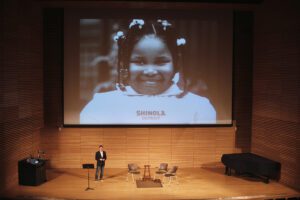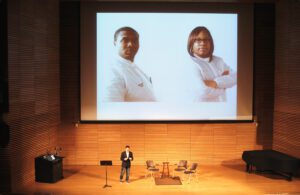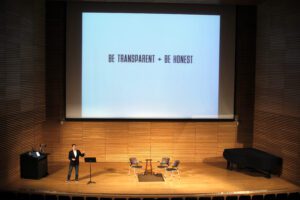

There was great clarity in the post-Civil War Confederate monument. Solid materials erected in a city’s central square to carry an unambiguous message: honor white supremacy and intimidate African Americans. While we celebrate the removal of these granite and bronze statues from plazas around the country, it’s worth considering whether their messages find new, unsettling, and implicit forms in places where we don’t expect them to materialize.
One of the most surprising sites is the university classroom. Almost every university now has “entrepreneurial” programming that partners with businesses claiming to be creative and innovative. These centers offer curriculum posing as education, though without pedagogical complexity, intellectual rigor, criticality, or historical perspective, and without questioning the social values implicitly expressed through the company’s messaging. These interlopers into education adopt the manner of cheerleaders, rather than of skeptics, carelessly draping collegiate gowns over values such as white supremacy. When white privilege is celebrated and validated by universities, how can we possibly ask students to acknowledge and confront racism?
Entrepreneurship 407: Shinola LLC

On March 15, 2015, Jacques Panis, then-president of the company Shinola LLC, was invited by the Center for Entrepreneurship to present to the hundreds of students enrolled in their Entrepreneurship Hour, a one-credit class offered for elective credit at the University of Michigan. Shinola has been hailed as an American success story — proof that “high-end” manufacturing can successfully return to the United States and benefit workers and the urban communities in which they live. All Shinola watches are assembled in the U.S., although most parts are manufactured in Switzerland and Thailand.
During the hour-long presentation, Panis celebrated himself and the other white Shinola designers and managers as leaders who had the vision to see that “There is no reason why this quality that we have already achieved [in Europe] can’t be transferred to Detroit.” In Panis’s telling, these intrepid, “crazy” white people ventured into the “heart of Detroit … where you used to go get your drugs” to open up a “factory” where luxury watches are assembled by Detroiters thankful for the jobs. Panis touted Shinola as a job-creation company, a claim at the heart of their marketing campaign, which presents the company as a noble philanthropic effort to “raise up” Detroit.
Panis made it clear that the extensively imaged African American employees (the indigenous people at the heart of Shinola’s visual marketing) only became employed at Shinola once they had “passed vision and acuity tests.” Here, Panis asserts dominance by evoking the scene of inspection at the auction block and describing African Americans as a compliant group that can be trained to be useful workers, very different language than he used to tell the U-M students about the white designers whom Panis said he relentlessly pursued until they joined the company.
In another brand video presented during Panis’s lecture, Shinola asks: “Why not accept that manufacturing is gone from this country? And why not let the rust and weeds finish what they started?” Detroit’s ruin is presented as the natural and innocent progression of forces, like dandelions and crabgrass, rather than the consequence of intentional disinvestment in the city (by the same sorts of companies now gobbling it up) or the product of institutionalized, racist forces that decisively obstructed and sabotaged the accumulation of wealth in the African American community. The “failure” of Detroit is no failure for white investors; in fact, Panis talked about it with the same glee that radiated from him during his summing-up of Detroit’s 2013 bankruptcy: “you get to wipe the slate clean and start over and it sounded great to us.” In this “Let them eat cake” moment, Panis expresses to students the true lessons of the day. First, Detroit’s ruin is the bread and butter of Shinola: the more tragic the city, the easier to sell its souvenirs. Second, while the African American community might lose half its wealth as a result of the housing crisis or lose its political capital after being forced into bankruptcy by a white state legislature, our institutions protect rich white men from financial trauma: they always have a second chance.
Panis ended the talk with a Shinola brand video, a poem recited by a young African American to an elder, describing her love for Detroit, a city of empty houses and abandoned fields that will rise from the ashes. Presented in black-and-white amidst a montage of clips showing an imported, New York, blond supermodel hugging a black child and bicycling through the streets with an interracial entourage, the video depicts Detroit as a city where fifty years of disinvestment and lack of quality education and substandard services, like garbage removal, policing, and transportation, are salved through poetic optimism and the caress of a white woman, transforming Detroit into a land of harmonious racial relationships. Shinola sells white supremacy with a twist — the luxury watch simultaneously serves as a symbol of white oversight and ingenuity and as an opportunity to be associated with the grit and resilience of Detroit. In his final moment on the stage, Panis deceptively reframes imperialism as “community,” using the word twelve times within forty-six seconds, before sending the students off on their own mission, challenging them to start their ventures in Detroit by considering: “how do you get those people to be your ambassadors.”
This monument to white supremacist ideology, was erected, not in a tree-lined roundabout in Charlottesville, Virginia, but on the stage of the Stamps Auditorium at the University of Michigan. Presented as part of an educational curriculum, without opportunity for public commentary or questions, the Center for Entrepreneurship effectively gave Panis the platform for an infomercial on Shinola products and how value can be extracted from indigenous communities. While Panis told students that “the consumer wants a story,” he simultaneously presented Shinola’s manufactured story to them as fact, not as an honest discussion of the marketing campaign. The omissions are as glaring as the fabrications. For example, Panis never informed the U-M students that Shinola’s parent company, Bedrock Brands, based in Texas, did extensive research before choosing Detroit as their subject and location, polling consumers to find out which city had more street credibility. Nor did he acknowledge that Bedrock chose Detroit because they saw that white-owned entrepreneurial efforts in the city generate free national press coverage.

Educating Impartially, Without Fear or Favor
If the basis of education is the attempt to honestly present information in order to analyze it with the distance that enables candid and critical reflection, then the Center failed that day. When an institution of higher learning begins to present brand messaging as truth — without commentary, dialogue, or criticism — we become no different than unfiltered commercial media channels. Moreover, our Hail to the Victors irresponsibly validates these sources. In that sense, this “lecture” and other negligent opportunistic collisions between education and commerce are the academic version of “fake news,” although presented by the academy rather than by Russian operators sabotaging from the outside. “Fake education” presents misinformation and spin as fact, within the context of education but without the processes: learning, thinking, questioning, reflecting, and growing.
That day in Stamps Auditorium, I looked around for signs that others were stunned by the rhetoric of the talk. I saw none. Students casually gathered their backpacks and flocked around Jacques Panis, presumably to ask about internship opportunities. It’s possible to assume that the students were not prepared to respond critically or to ask serious questions, even if given the opportunity. Is this because the director of the Entrepreneur program closed the lecture by encouraging students to shop at the new Ann Arbor Shinola store and by commending Panis for inventing new processes and challenging the status quo, thus, again, cloaking this rhetoric in the jargon of innovation? Had students in the program been indoctrinated, through isolationist tactics that separate business from social criticism, or with influence techniques like “high-five Fridays,” into a rah-rah mentality toward business practices? Or, having witnessed the Great White Hope being erected on stage, was it just not comfortable to try to take it down?
Rebekah Modrak
Volume 33 no 2 November / December 2018 pp 28-30
Background
Artist and writer Rebekah Modrak created the artwork Rethink Shinola in order to provide the public with an accurate version of the Center for Entrepreneurship’s Jacques Panis lecture. Rethink Shinola analyzes, critiques and exposes a complex and patronizing agenda of marketing white supremacy, Black labor, and authenticity with Detroit as the central subject. The work features a meticulous re-creation of the lecture, re-performed by an actor in the original lecture hall. An earlier article “Bougie Crap” analyzes the links between design, education, corporate culture and the appropriation of images and symbols of labor and blackness by luxury producers. Rebekah is the lead author of Reframing Photography, a book critically exploring photographic representation, ethics, re-enactments, and other issues within the image-based world. She is the creator of Re Made Co., an artwork posing as a “company.” Re Made recreates actual company Best Made Co. to critique their appropriation of working class identities and the revitalization of traditional male roles. Rebekah is an Associate Professor in the Stamps School of Art & Design at the University of Michigan.

